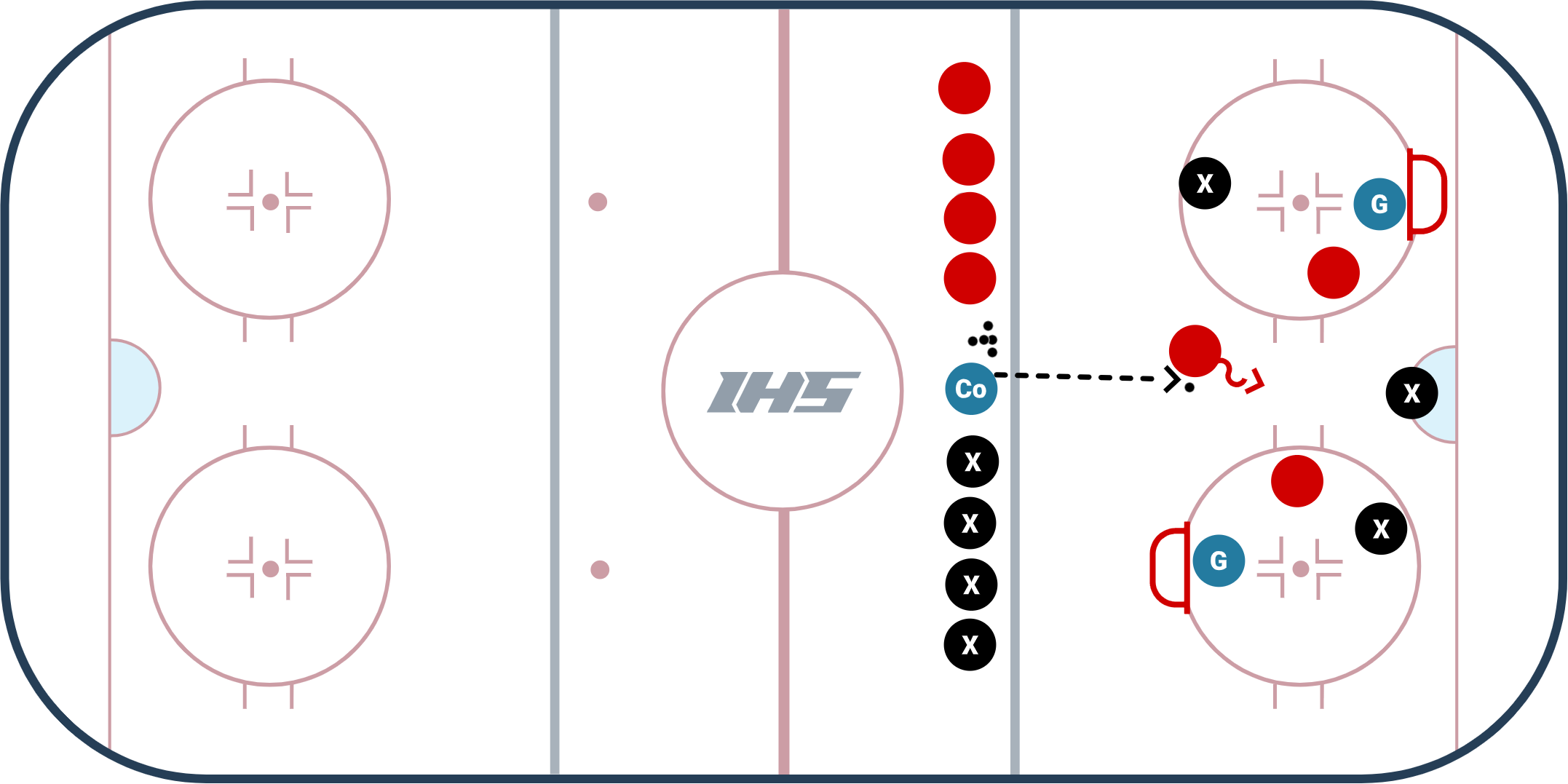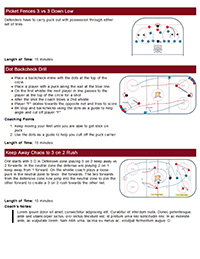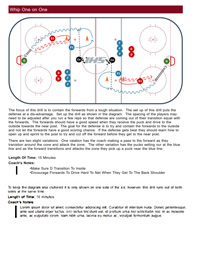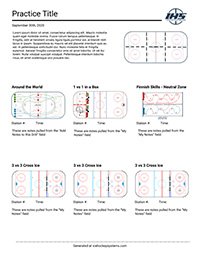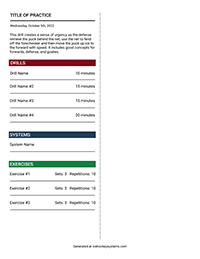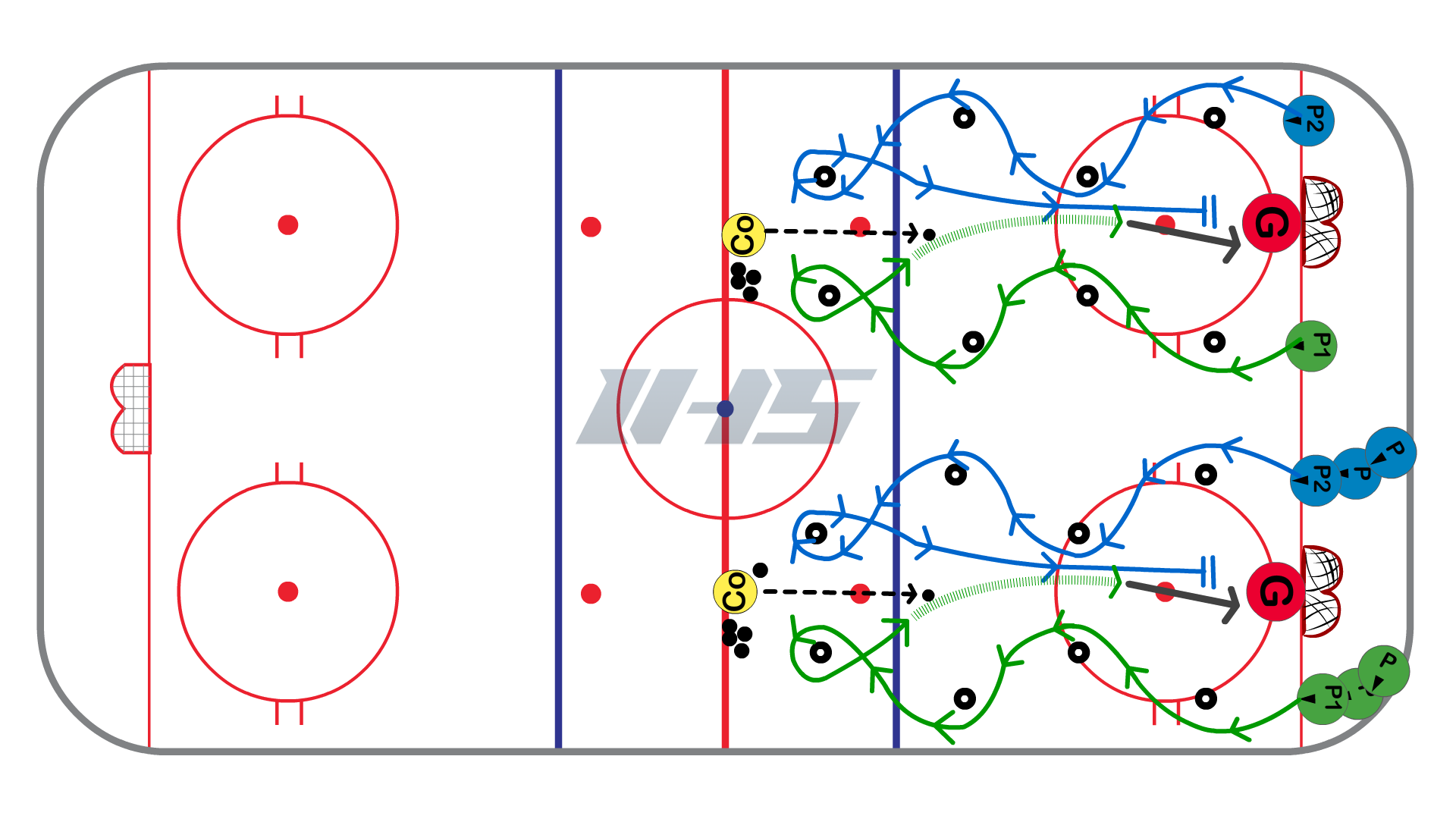
U10 - Compete Drills & Games
U10 - Compete Drills & Games

This practice plan is focused on fun and engaging competitions for players to use their skills to battle and work together. Modify the goals or points systems in each game based on your team's level and ability.
This practice encourages age-appropriate situations for 1v1, 2v2, and 3v3. A great way to build instincts, teamwork and skills in fun, game-like situations.
Practice Layout
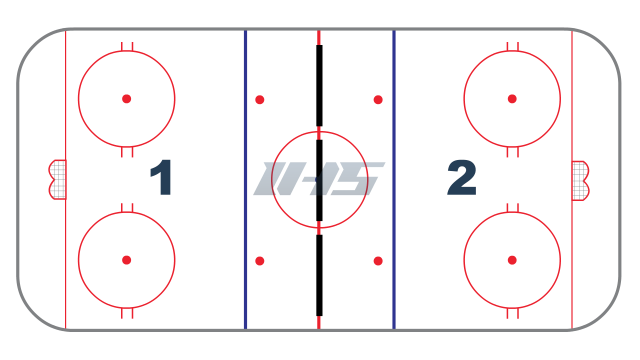
3 vs. 3 Handball Game
The 3 vs. 3 Handball Game from Topher Scott of The Hockey Think Tank is a fun game that reinforces offensive principles. Teams will have to communicate and perform lots of give & go's to be successful. No sticks and no pucks. Use any type of ball: soccer ball, basketball, football or anything else (even an extra glove can work)!
Setup:
- 2 nets and two teams.
- Can only have the ball for 2 seconds (for younger teams or less skilled players you can increase that time). You must get rid of the ball quick (give & go!)
- If a player has the ball for longer than 2 seconds, the coach blows the whistle and there is a change of possession.
- If the ball falls to the ice, it is a change of possession.
- 15 - 30 second shifts. Encourage players watching to cheer their teammates on.
Coaching Points:
- Give and go's!
- Support the ball by being an outlet for your teammate.
- Get open!
Variations:
- Can be 2v2, 3v3, 4v4.
- Can be set up as a station or a half-ice game.
- Can add goalies (even players as goalies).
- Can let players hold on to the ball longer than 2 seconds.
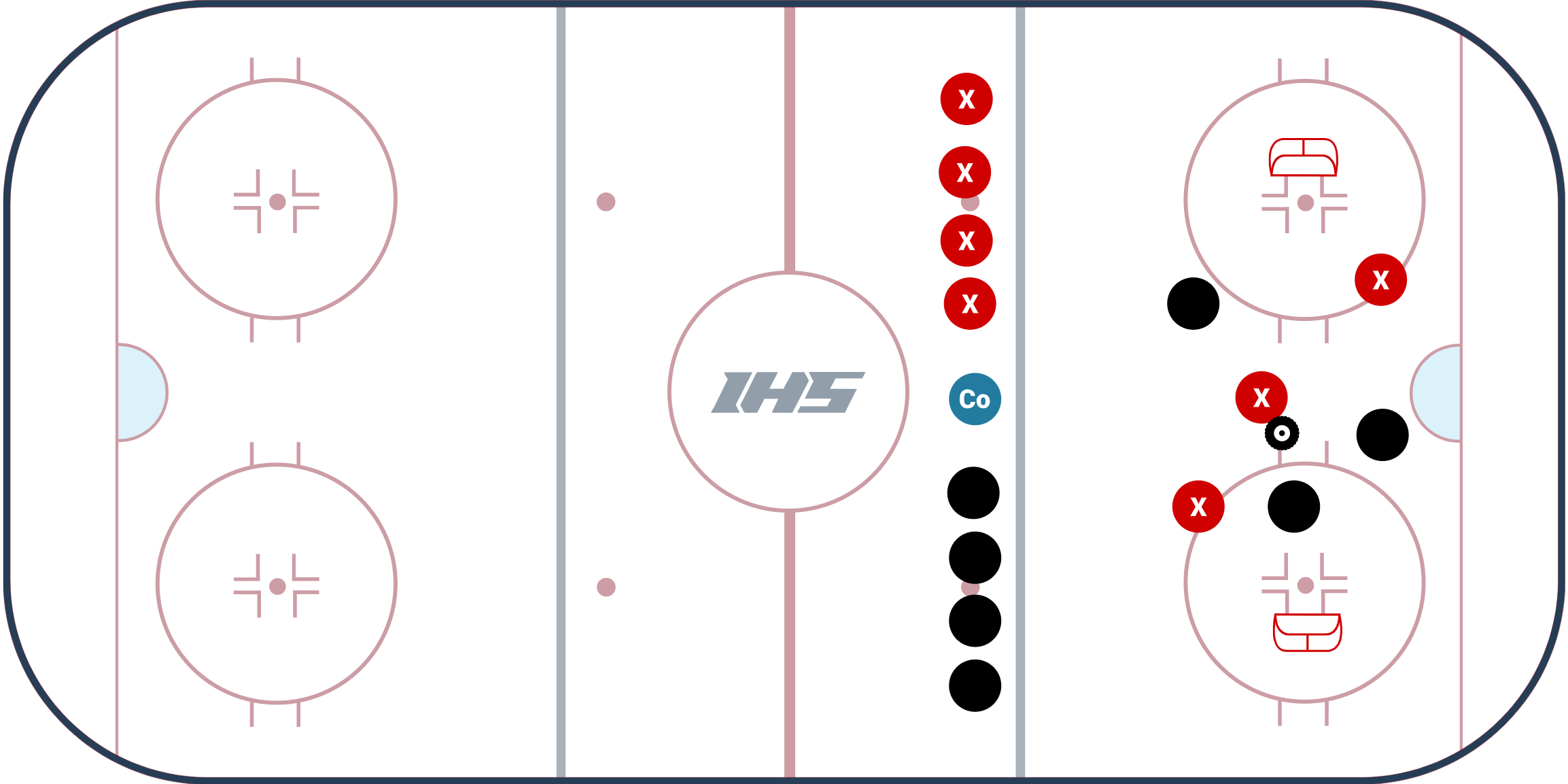
A great way to get players to think about spacing and puck support. Start practice with this game to get the competitiveness started right away, while also encouraging communication and letting the players figure out how they can work together to score goals.
Gates of Buffalo Small Area Passing Game
The major concept of the Gates of Buffalo Small Area Hockey Game is to practice moving to open space, communicating verbally and non-verbally with teammates, so they can score Goals by passing through Gates.
This game framework will help players learn to play with their head up, communicate with teammates and move to open space.
As a coach, If you commit to working on activities like this instead of memorization drills for a portion of each practice, you will marvel at how your team begins to work together. It will look extremely messy at first, but players will get better with each repetition. Moving to open space, and moving the puck will eventually become second nature to the team.
GAME OBJECTIVE
- Score as many goals as possible by passing through the "Gates."
- You can not pass through the same gate twice in a row!
SETUP & ACTIVITY VARIABLES
- Players: great for 3, 4 or 5 players at a time.
- Time: You can rotate through groups of players in 30, 45 or 60 second shifts and count how many goals are scored.
- Or you can set a number of goals (let's use 5 for example) and stop the watch after 5 goals are completed.
- 5 players can be participating in the activity, while another 5 rest. Blow the whistle and the next 5 jump in. It gets fun when the teams compete against each other!
- Space: can be set up to be within a zone, or half of a zone (station) or a smaller area. The smaller the space, the more challenging it will be for the players as they are forced to make quicker decisions.
- Added Challenge: add obstacles within the space to challenge the players further.
- Tires, cones, sticks, defenceman, etc placed in the space will make it harder to pass and skate around. As time goes on the added obstacles will help improve their reaction & decision making.
- Group Competition: After the group gets comfortable with the exercises, you can add a natural element of competition between the groups by counting the number of successful goals made in the specified amount of time.
- Or you can time each group and see how fast they can complete 5 (or any other number) goals. You will marvel at how the natural element of competition between groups will make the game more intense, competitive and fun!
- With a Goalie: You can require the players to make 2 (or more) passes through a gate before they can shoot on net. After they shoot on net, they need to make the required number of passes through the gates again.
- Pucks: You can add in 2 or more pucks at a time to make players pay more attention to the game and their surroundings.
- Gates: You can add 3 or more gates. They can be made of tires, cones, pucks and other materials. Change up the sizes of the gates for an extra challenge. The smaller the gate, the more challenging the game is!
- 3 vs 3 Game: You can setup gates and make the game 3 v 3, 3 vs 2, or 3 vs 1 so there is another team working to prevent scoring on the gates. Adding additional players for the team to play against will give the game a whole new spin. View a video demo of the 3 vs 3 game setup.
Setup Suggestions for Elite Players
- Make the gates much smaller.
- You can add a hockey stick at the bottom of each gate so players must "sauce" through a gate and over the stick for the point.
- Add various obstacles on the ice such as sticks that players must be aware of and pass around or sauce over.
- For extra fun, add a defenceman. Or play 3 vs 2 or 3 vs 3.
- If you have a goalie, require 2 or more passes through the gates before players are allowed to take a shot on net.
COACHING POINTS
- Encourage players to always move to open space on the ice. Do not allow them to stand still and pass the puck back and forth.
- Encourage players to find "passing lanes" to allow good passes.
- This skill is extremely valuable for youth players to work on. Finding passing lanes when you have the puck and jumping to open space when you don't have the puck so your teammate can pass to you is extremely beneficial during games.
- Encourage verbal communication (calling teammate by name, saying you are open, etc).
- Encourage non-verbal communication (good eye contact, showing a passing target, tapping a stick, etc).
- Allow players to make mistakes. It will take time to get comfortable with these activities. But as time goes on you will see them picking their head up to make a decision, which is the goal of this small area game.
Why do we call this small area game "Gates of Buffalo?" The game has been called "gates" in the world of soccer and we decided to add Buffalo to it for two fun reasons: First, IHS has strong ties to Buffalo, NY. Secondly, the imagery of a Buffalo can help drive home to your youth players why you are practicing this game. If you do not pick your head up and use your teammates while playing the game of hockey, you run the risk of getting trampled by the other team. This can feel like getting run over by a Buffalo (physically or on the scoreboard). This game helps prevent both of those situations by forcing players to keep their head up while communicating and working with teammates to score goals.
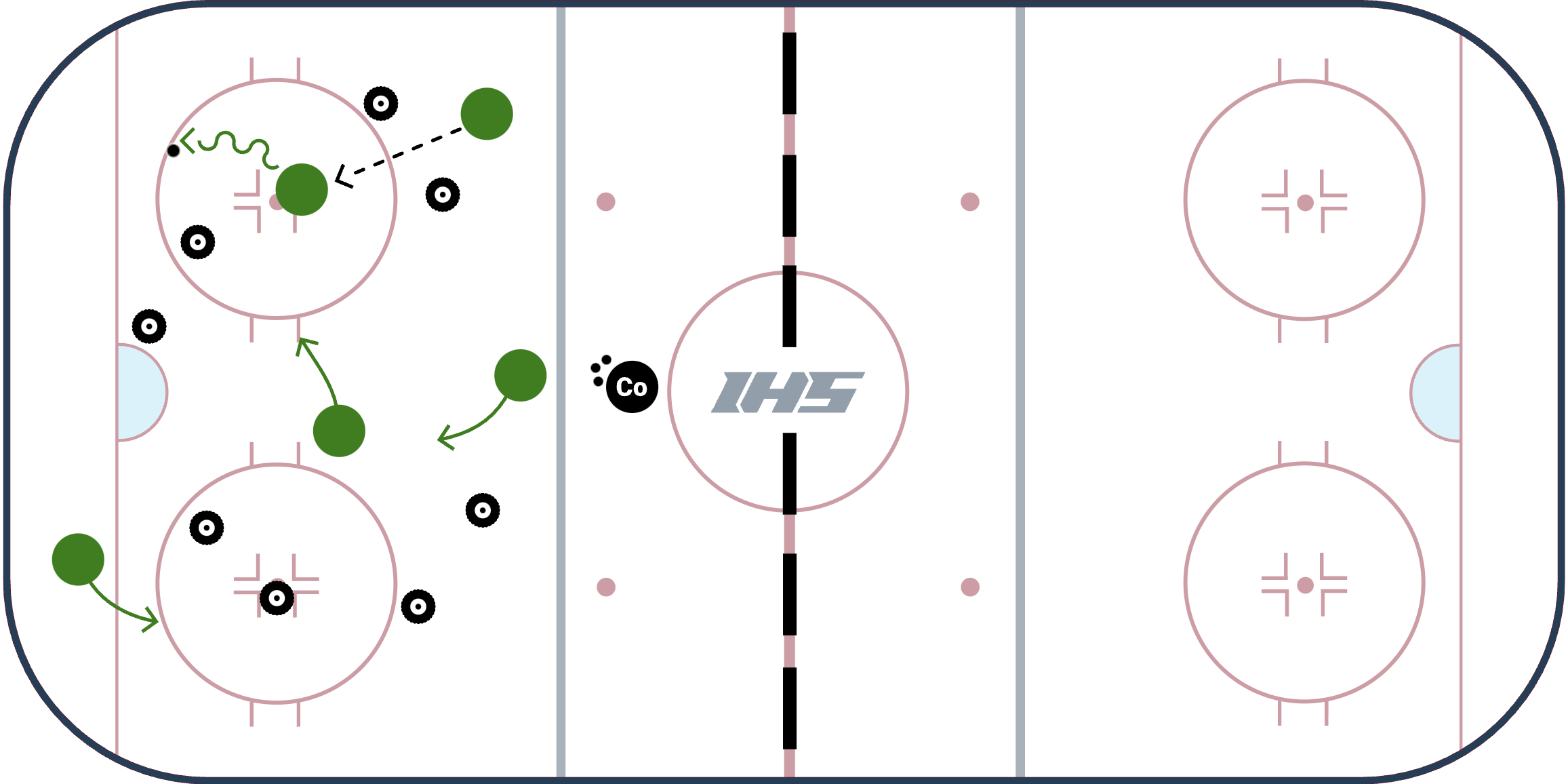
Keep score based on number of successful passes made between the gates.
Half Ice Slalom Races
Add some competition to your practice with this drill while working on footspeed, agility, control turns, and scoring. If you have access to two nets then split your half of the ice into two equal sections as shown in the diagram. Line the nets up even with the face off dots and place one line on each side. The tires or cones should be set up as shown.
On the whistle players start by going to the outside of the first tire. At the last tire the players do a control turn all the way around the tire starting on the inside. The coach will play a 50/50 puck towards the net and the players will compete for the puck the first player to touch the puck is on offense and the second player becomes the defender and backchecks against the player with the puck.
Incorporate skating and puck protection skills with relay races.
Corner Boards 1 V 1 Loose Puck Battle
Corner Boards 1 V 1 Loose Puck Battle allows players & coaches to work on a very common play during the game, a loose puck battle along the boards. This is a competitive drill that can also progress to 2 V 2.
Setup
- On the whistle, 2 players battle in the corner for a loose puck.
- Whoever gets the puck off of the boards first is on offense and tries to score a goal while the other player defends.
- Defenders can knock the puck out of play or they can steal the puck, tag up at the goal line and then become an offensive player.
Variations
- Can make the battle 1 V 1 and progress to 2 V 2. View 2 V 2 Tag Up Example.
- Can allow the defending team to tag up at the goal line to become offense.
Coaching Points
- Defending players need to keep their sticks on the ice and play the body.
- Offensive players should work to protect the puck with their body and utilize their edges to be strong on the puck and create space with tight turns.
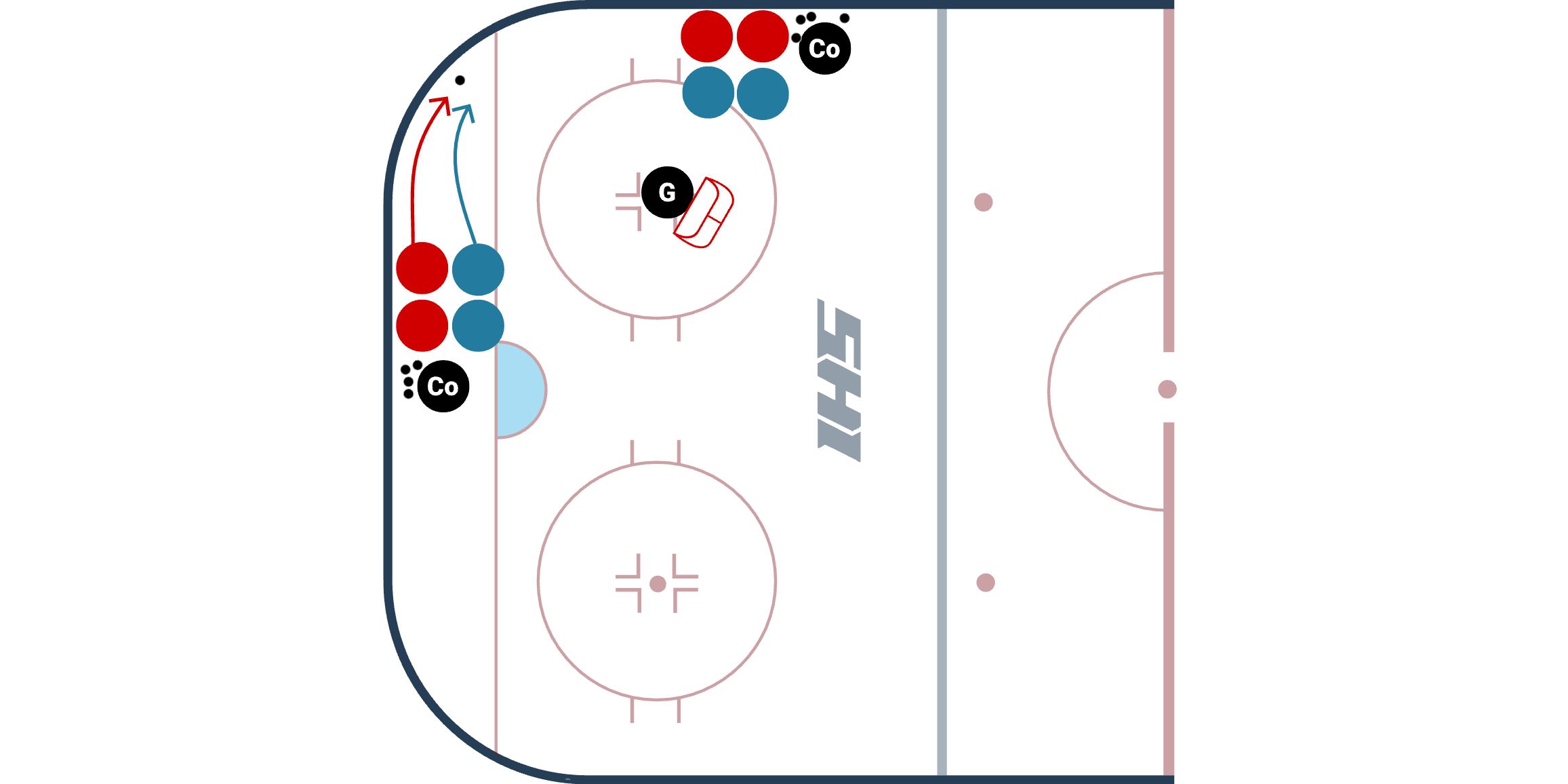
Progress to 2v2
Double Gates Activation Game
The Double Gates Activation Game from Coach Alyssa Gagliardi is a competitive small area game that starts out as a 1 on 1 and becomes a 2 on 1 after a player skates through one of the gates. This can also be modified to be a 2 on 2 that becomes a 3 on 2.
Setup
- Place a gate (gates can be made by tires, cones, etc) on each side of the net. This will create two gates and two options for the offensive player to skate though.
- Place one forward and one defender in one of the corners or circles.
- Place an additional player at the high slot or point.
- To start: a coach chips a puck in the corner to begin a 1 on 1 battle.
- The forward is trying to first skate through a gate. Once the forward skates through the gate, they are able to pass it to the open player at the point to begin a 2 on 1. The offensive team is trying to score a goal.
- The defender is trying to strip the puck during the 1 on 1 and/or the 2 on 1 and skate out of the zone.
- The coach can stop the play when there is a goal, the defender skates the puck out of the zone, the goalie freezes the puck or enough time has passed (15 - 30 seconds).
Coaching Points
- Offensive player:
- Look over your shoulder to see where the pressure is coming from.
- Do not expose the puck until you are ready to make a play. Use the net and the boards to protect the puck!
- Keep head up to be aware of where the gates are and the extra player is.
- Defending player:
- Work on taking a good angle.
- Keep your stick on the ice to go after the puck and to block passing lanes.
Game Variations
- Can allow the forward to immediately try to score a goal, or you can require them to first go through the gate before they can score. Either way, if they go through the gate the other forward is activated.
- Can set up gates in different areas of the ice.
- Can add gates at the blueline that the defense needs to skate through instead of skating over the blueline.
- Can start the game in different areas of the zone.
- Can setup the game in smaller areas of the ice (example - 1/4 ice instead of 1/2 ice.)
- Can be modified to be a 2 on 2 that becomes a 3 on 2 (diagram displayed below)
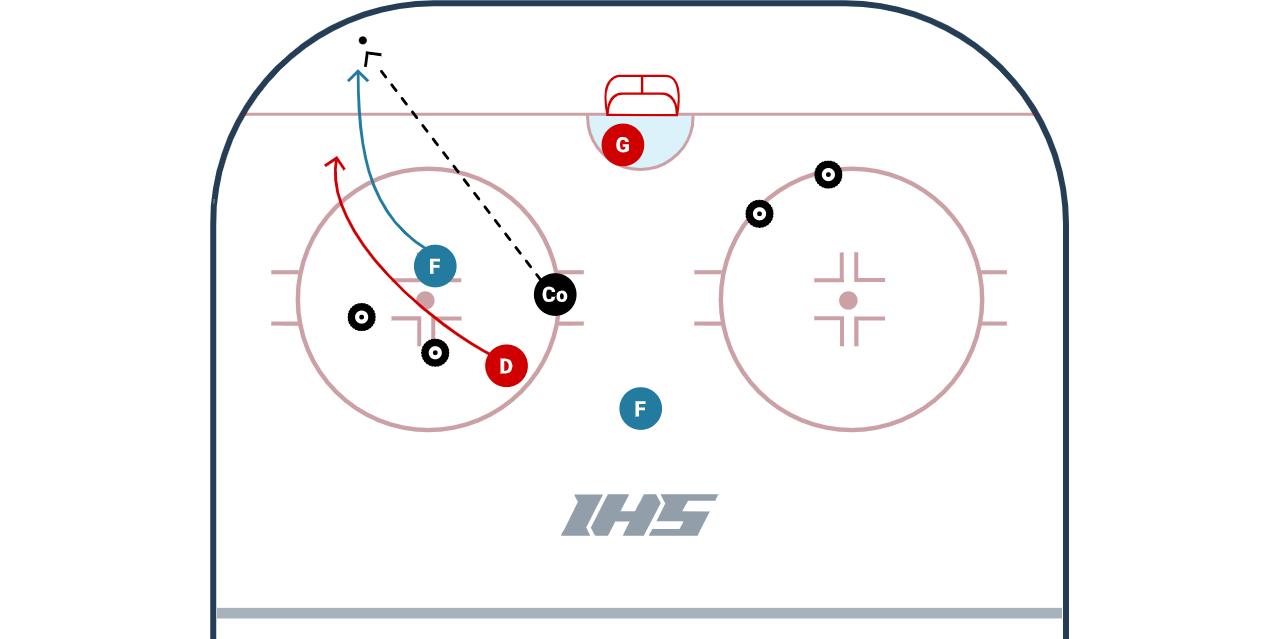
Progress the drill to start as a 2v2 with the opportunity to activated a third player to make it a 3v2.
Union Small Area Scoring Game
The Union Scoring Small Area Game from Topher Scott is a fun small area game where teams can score on either net. The unique setup of the nets promotes creativity, thinking outside of the box to create time & space and score goals.
Setup
- Coach chips the puck into the zone or passes to one of the players to begin the 3 vs. 3 game.
- Players can score on either net.
- Game can be stopped when a goal is scored, the goalie freezes the puck, or the coach blows the whistle. Keep score!
Coaching Points
- Head up: Players should be aware of where the other team and their teammates are. There will be lots of creative options available if you play with your head up!
- Stick on the ice: It helps the defense angle and remove passing lanes. It helps forwards tell each other where they want a pass.
- Space: Forwards work to create time and space. Defense work to take away time and space.
